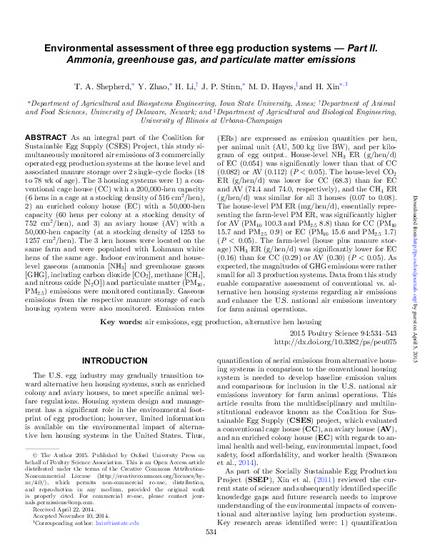
As an integral part of the Coalition for Sustainable Egg Supply (CSES) Project, this study simultaneously monitored air emissions of 3 commercially operated egg production systems at the house level and associated manure storage over 2 single-cycle flocks (18 to 78 wk of age). The 3 housing systems were 1) a conventional cage house (CC) with a 200,000-hen capacity (6 hens in a cage at a stocking density of 516 cm2/hen), 2) an enriched colony house (EC) with a 50,000-hen capacity (60 hens per colony at a stocking density of 752 cm2/hen), and 3) an aviary house (AV) with a 50,000-hen capacity (at a stocking density of 1253 to 1257 cm2/hen). The 3 hen houses were located on the same farm and were populated with Lohmann white hens of the same age. Indoor environment and house-level gaseous (ammonia [NH3] and greenhouse gasses [GHG], including carbon dioxide [CO2], methane [CH4], and nitrous oxide [N2O]) and particulate matter (PM10, PM2.5) emissions were monitored continually. Gaseous emissions from the respective manure storage of each housing system were also monitored. Emission rates (ERs) are expressed as emission quantities per hen, per animal unit (AU, 500 kg live BW), and per kilogram of egg output. House-level NH3 ER (g/hen/d) of EC (0.054) was significantly lower than that of CC (0.082) or AV (0.112) (P< 0.05). The house-level CO2 ER (g/hen/d) was lower for CC (68.3) than for EC and AV (74.4 and 74.0, respectively), and the CH4 ER (g/hen/d) was similar for all 3 houses (0.07 to 0.08). The house-level PM ER (mg/hen/d), essentially representing the farm-level PM ER, was significantly higher for AV (PM10 100.3 and PM2.5 8.8) than for CC (PM10 15.7 and PM2.5 0.9) or EC (PM10 15.6 and PM2.5 1.7) (P < 0.05). The farm-level (house plus manure storage) NH3 ER (g/hen/d) was significantly lower for EC (0.16) than for CC (0.29) or AV (0.30) (P < 0.05). As expected, the magnitudes of GHG emissions were rather small for all 3 production systems. Data from this study enable comparative assessment of conventional vs. alternative hen housing systems regarding air emissions and enhance the U.S. national air emissions inventory for farm animal operations.
Available at: http://works.bepress.com/hongwei_xin/270/

This article is from Poultry Science 94 (2015): 534–543, doi:10.3382/ps/peu075. Posted with permission.